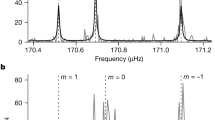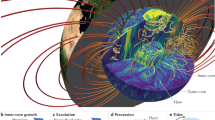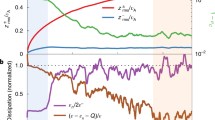Abstract
Magnetic fields at the Earth’s surface represent only a fraction of the field inside the core1. The strength and structure of the internal field are poorly known2,3,4,5, yet the details are important for our understanding of the geodynamo. Here I obtain an indirect estimate for the field strength from measurements of tidal dissipation. Tidally driven flow in the Earth’s liquid core develops internal shear layers, which distort the internal magnetic field and generate electric currents. Ohmic losses damp the tidal motions and produce detectable signatures in the Earth’s nutations. Previously reported evidence of anomalous dissipation in nutations3,6 can be explained with a core-averaged field of 2.5 mT, eliminating the need for high fluid viscosity6 or a stronger magnetic field at the inner-core boundary3. Estimates for the internal field constrain the power required for the geodynamo7,8.
This is a preview of subscription content, access via your institution
Access options
Subscribe to this journal
Receive 51 print issues and online access
$199.00 per year
only $3.90 per issue
Buy this article
- Purchase on Springer Link
- Instant access to full article PDF
Prices may be subject to local taxes which are calculated during checkout



Similar content being viewed by others
References
Aubert, J., Labrosse, S. & Poitou, C. Modelling the palaeo-evolution of the geodynamo. Geophys. J. Int. 179, 1414–1428 (2009)
Zatman, S. & Bloxham, J. Torsional oscillations and the magnetic field within the Earth’s core. Nature 388, 760–763 (1997)
Mathews, P. M., Herring, T. A. & Buffett, B. A. Modeling of nutation and precession: new nutation series for nonrigid Earth and insights into the Earth’s interior. J. Geophys. Res. 107, 2068 (2002)
Buffett, B. A., Mound, J. & Jackson, A. Inversion of torsional oscillations for the structure and dynamics of Earth’s core. Geophys. J. Int. 177, 878–890 (2009)
Gillet, N., Jault, D., Canet, E. & Fournier, A. Fast torsional waves and strong magnetic field within the Earth’s core. Nature 465, 74–77 (2010)
Koot, L., Dumberry, M., Rivoldini, A., de Viron, O. & Dehant, V. Constraints on the coupling at the core-mantle and inner-core boundaries inferred from nutation observations. Geophys. J. Int. 182, 1279–1294 (2010)
Jackson, A. & Livermore, P. On ohmic heating in the Earth’s core: nutation constraints. Geophys. J. Int. 177, 367–382 (2009)
Christensen, U. R. & Tilgner, A. Power requirements of the geodynamo from ohmic losses in numerical and laboratory dynamos. Nature 429, 169–171 (2004)
Poincaré, H. Sur la precession des corps deformables. Bull. Astron. 27, 321–356 (1910)
de Wijs, G. A. et al. The viscosity of liquid iron at the physical conditions of the Earth’s core. Nature 392, 805–807 (1998)
Dobson, D. P. Self-diffusion in liquid Fe at high pressure. Phys. Earth Planet. Inter. 130, 271–284 (2002)
Hollerbach, R. & Kerswell, R. R. Oscillatory internal shear layers in rotating and precessing flows. J. Fluid Mech. 298, 327–339 (1995)
Tilgner, A. Driven inertial oscillations in spherical shells. Phys. Rev. E 59, 1789–1794 (1999)
Rieutord, M. & Valdettaro, L. Inertial waves in a rotating spherical shell. J. Fluid Mech. 341, 77–99 (1997)
Walton, I. C. Viscous shear layers in an oscillating rotating fluid. Proc. R. Soc. Lond. A 344, 101–110 (1975)
Kerswell, R. R. On the internal shear layers spawned by the critical regions in oscillatory Ekman boundary layers. J. Fluid Mech. 298, 311–325 (1995)
Wahr, J. M. & Bergen, Z. The effects of mantle anelasticity on nutations, Earth tides and tidal variations in the rotation rate. Geophys. J. R. Astron. Soc. 87, 633–668 (1986)
Desai, S. & Wahr, J. M. Empirical ocean tide models estimated TOPEX/Poseidon altimetry. J. Geophys. Res. 100, 25205–25228 (1995)
Mathews, P. M., Buffett, B. A., Herring, T. A. & Shapiro, I. I. Forced nutations of the Earth: influence of inner core dynamics, 1.Theory. J. Geophys. Res. 96, 8219–8242 (1991)
Buffett, B. A., Mathews, P. M. & Herring, T. A. Modeling of nutation and precession: effects of electromagnetic coupling. J. Geophys. Res. 107, 2070 (2002)
Christensen, U. R. & Aubert, J. Scaling properties of convection-driven dynamos in rotating spherical shells and application to planetary magnetic fields. Geophys. J. Int. 166, 97–114 (2006)
Starchenko, S. V. & Jones, C. A. Typical velocities and magnetic field strengths in planetary interiors. Icarus 157, 426–435 (2002)
Sovers, O. J., Fanselow, J. L. & Jacobs, C. S. Astrometry and geodesy with radio interferometry: experiments, models, results. Rev. Mod. Phys. 70, 1393–1454 (1998)
Kuang, W. & Bloxham, J. Numerical modeling of magnetohydrodynamic convection in a rapidly rotating spherical shell: weak and strong field dynamo action. J. Comput. Phys. 153, 51–81 (1999)
Saad, Y. & Schultz, M. H. GMRES: a generalized minimal residual algorithm for solving nonsymmetric linear systems. SIAM J. Sci. Stat. Comput. 7, 856–869 (1986)
Tilgner, A. in Treatise on Geophysics Vol. 8 (ed. Schubert, G.) 207–243 (Elsevier, 2007)
Mathew, P. M., Buffett, B. A., Herring, T. A. & Shapiro, I. I. Forced nutations of the Earth: influence of inner core dynamics, 2. Results. J. Geophys. Res. 96, 8219–8242 (1991)
Author information
Authors and Affiliations
Corresponding author
Ethics declarations
Competing interests
The author declares no competing financial interests.
Supplementary information
Supplementary Information
The file contains Supplementary Text comprising: Width of the Shear Layers and Influence of Electromagnetic Force on Inertial Waves. The file also contains Supplementary Figures 1-2 with legends and additional references. (PDF 154 kb)
Rights and permissions
About this article
Cite this article
Buffett, B. Tidal dissipation and the strength of the Earth’s internal magnetic field. Nature 468, 952–954 (2010). https://doi.org/10.1038/nature09643
Received:
Accepted:
Published:
Issue Date:
DOI: https://doi.org/10.1038/nature09643
This article is cited by
-
Core Eigenmodes and their Impact on the Earth’s Rotation
Surveys in Geophysics (2022)
-
Intradecadal variations in length of day and their correspondence with geomagnetic jerks
Nature Communications (2020)
-
Phenomenology of magnetic black holes with electroweak-symmetric coronas
Journal of High Energy Physics (2020)
-
Geomagnetic spikes on the core-mantle boundary
Nature Communications (2017)
-
Evaluation of Simulated Microgravity Environments Induced by Diamagnetic Levitation of Plant Cell Suspension Cultures
Microgravity Science and Technology (2016)
Comments
By submitting a comment you agree to abide by our Terms and Community Guidelines. If you find something abusive or that does not comply with our terms or guidelines please flag it as inappropriate.



